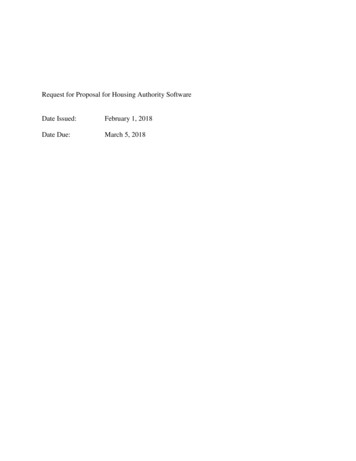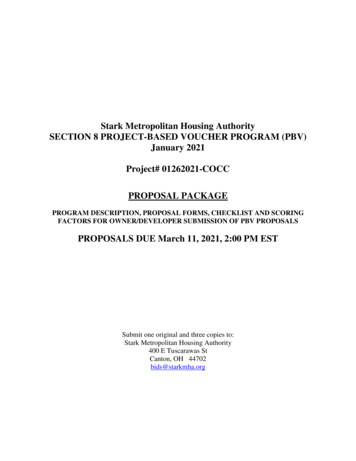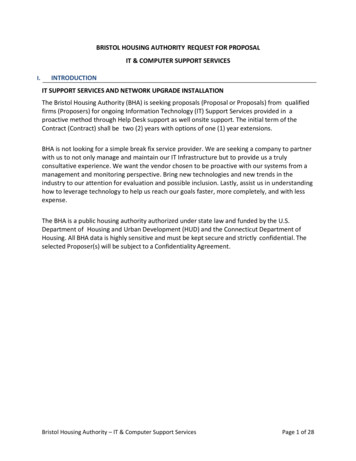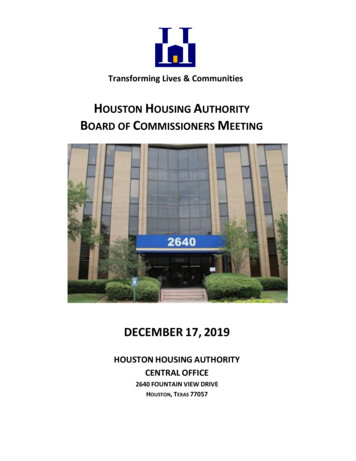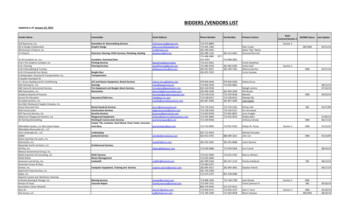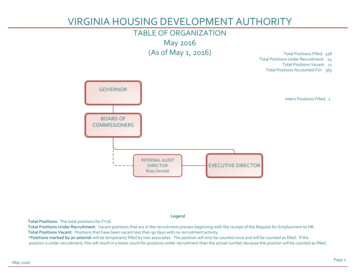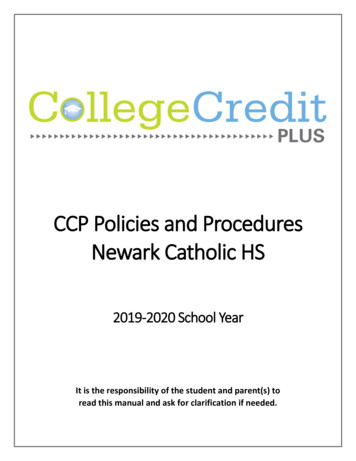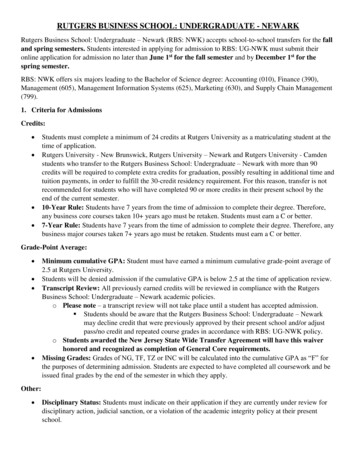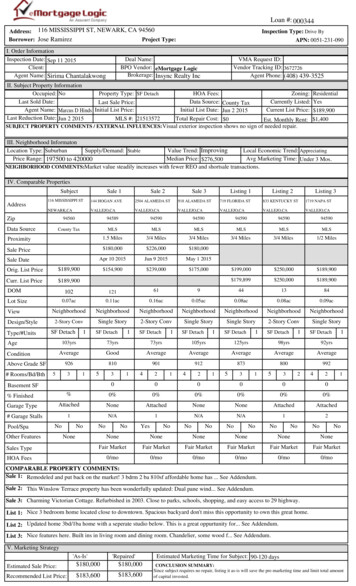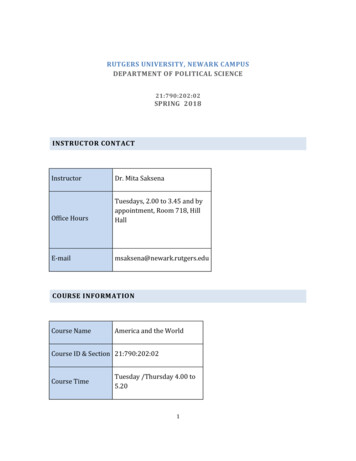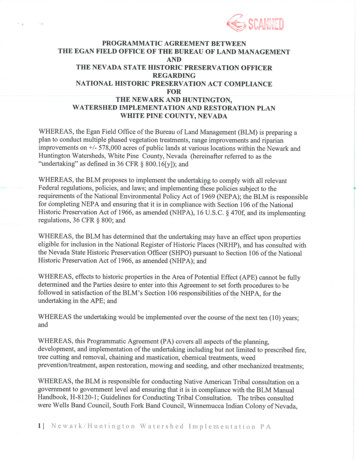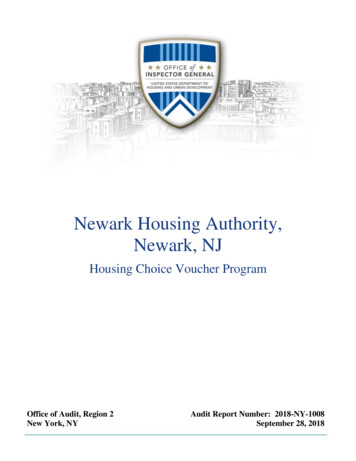
Transcription
Newark Housing Authority,Newark, NJHousing Choice Voucher ProgramOffice of Audit, Region 2New York, NYAudit Report Number: 2018-NY-1008September 28, 2018
To:From:Subject:Theresa Arce, Director, Office of Public and Indian Housing, Newark FieldOffice, 2FPH//SIGNED//Kimberly S. Dahl, Regional Inspector General for Audit, 2AGAThe Newark Housing Authority, Newark, NJ, Did Not Ensure That Units MetHousing Quality Standards and That It Accurately Calculated AbatementsAttached is the U.S. Department of Housing and Urban Development (HUD), Office of InspectorGeneral’s (OIG) final results of our review of the Newark Housing Authority’s Housing ChoiceVoucher Program.HUD Handbook 2000.06, REV-4, sets specific timeframes for management decisions onrecommended corrective actions. For each recommendation without a management decision,please respond and provide status reports in accordance with the HUD Handbook. Please furnishus copies of any correspondence or directives issued because of the audit.The Inspector General Act, Title 5 United States Code, section 8M, requires that OIG post itspublicly available reports on the OIG website. Accordingly, this report will be posted athttp://www.hudoig.gov.If you have any questions or comments about this report, please do not hesitate to call me at212-264-4174.
Audit Report Number: 2018-NY-1008Date: September 28, 2018The Newark Housing Authority, Newark, NJ, Did Not Ensure That Units MetHousing Quality Standards and That It Accurately Calculated AbatementsHighlightsWhat We Audited and WhyWe audited the Newark Housing Authority’s Housing Choice Voucher Program. We selected theAuthority for review because the U.S. Department of Housing and Urban Development (HUD)authorized more than 111 million in program funding for its Housing Choice Voucher Program infiscal years 2016 and 2017 and based on our risk analysis of public housing agencies located in theState of New Jersey. The objective of the audit was to determine whether the Authority ensuredthat its program units met HUD’s housing quality standards and whether it abated housingassistance payments when required.What We FoundThe Authority did not ensure that its program units met housing quality standards, and it did notaccurately calculate housing assistance payment abatements. Of 29 program units inspected, 25did not meet HUD’s housing quality standards, and 23 of those units materially failed to meetHUD’s standards. Further, the Authority incorrectly calculated the abatement amount for 4 ofthe 20 abated units reviewed. These conditions occurred because the Authority’s inspectors didnot apply their housing quality standards training to thoroughly inspect units and it did not haveadequate controls over the calculation of abatements. As a result, the Authority disbursed 110,943 in housing assistance payments for units that materially failed to meet HUD’s housingquality standards and paid its contractor 708 in fees to inspect these units. Additionally, itdisbursed 4,459 for housing assistance payments that should have been abated. Unless theAuthority improves its inspection program and controls over the calculation of abatements, itwill continue to pay housing assistance for units that materially fail to meet housing qualitystandards. Further, its program participants will continue to be subjected to unsafe livingconditions.What We RecommendWe recommend that HUD require the Authority to (1) certify, along with the owners of the 25units cited in the finding, that the applicable housing quality standards violations have beencorrected; (2) reimburse its program 111,651 for the 23 units that materially failed to meethousing quality standards; (3) improve controls over its inspection program; (4) reimburse itsprogram 4,459 for housing assistance payments that were not properly abated; and (5) improvecontrols over the calculation of abatements.
Table of ContentsBackground and Objective.3Results of Audit .4Finding: Housing Quality Standards Inspections Were Inadequate andAbatement Amounts Were Not Accurately Calculated . 4Scope and Methodology .13Internal Controls .15Appendixes .16A. Schedule of Questioned Costs . 16B. Auditee Comments and OIG’s Evaluation . 172
Background and ObjectiveThe Newark Housing Authority was established in 1938 after the passage of the Federal HousingAct of 1937 to build and manage public housing developments for residents of Newark, NJ. TheAuthority owns 8,067 public housing units, assists an additional 6,907 families through theSection 8 program, and operates various urban renewal programs. The Authority’s board ofcommissioners is comprised of seven members who serve 5-year terms. One member isappointed by the mayor, five members are appointed by the mayor with city council approval,and one member is appointed by the New Jersey Department of Community Affairs as delegatedby the governor.Under the Housing Choice Voucher Program, the U.S. Department of Housing and UrbanDevelopment (HUD) authorized the following financial assistance for the Authority’s housingchoice vouchers for fiscal years 2016 and 2017.Fiscal yearBudget authority2016 55,256,823201756,324,900HUD regulations at 24 CFR (Code of Federal Regulations) 982.405(a) require public housingagencies to perform unit inspections before the initial move-in and at least biennially. TheAuthority must inspect the unit leased to the family before the term of the lease, at leastbiennially during assisted occupancy, and at other times as needed to determine whether the unitmeets housing quality standards. HUD regulations at 24 CFR 982.404(a) require the Authorityto ensure that housing units and premises are maintained in accordance with HUD’s housingquality standards, and if not, the Authority is required to abate housing assistance payments tothe owners until the requirements are met.In October 2014, the Authority contracted with a service provider to perform housing qualitystandards inspections for its Housing Choice Voucher Program. The contract was for a 3-yearperiod, with an option to renew for up to two additional 1-year periods at the sole option of theAuthority. Specifically, the contract required the contractor to perform all of the dutiesassociated with the inspection function (including scheduling, inspections, rent reasonableness,and quality control inspections) of prospective units and units under housing assistance paymentscontracts for the Authority’s Housing Choice Voucher Program in accordance with the Federalhousing quality standards.Our audit objective was to determine whether the Authority ensured that its Housing ChoiceVoucher Program units met HUD’s housing quality standards and whether it abated housingassistance payments when required.3
Results of AuditFinding: Housing Quality Standards Inspections Were Inadequateand Abatement Amounts Were Not Accurately CalculatedThe Authority did not ensure that its units met housing quality standards, and it did notaccurately calculate housing assistance payment abatements. Of 29 program units inspected, 25did not meet HUD’s housing quality standards, and 23 of those units materially failed to meetHUD’s standards. Further, the Authority incorrectly calculated the abatement amount for 4 ofthe 20 abated units reviewed. These conditions occurred because the Authority’s inspectors didnot apply their housing quality standards training to thoroughly inspect units and it did not haveadequate controls over the calculation of abatements. As a result, the Authority disbursed 110,943 in housing assistance payments for units that materially failed to meet HUD’s housingquality standards and paid its contractor 708 in fees1 to inspect these units. Additionally, itdisbursed 4,459 for housing assistance payments that should have been abated. Unless theAuthority improves its inspection program and controls over the calculation of abatements, itwill continue to pay housing assistance for units that materially fail to meet housing qualitystandards. Further, its program participants will continue to be subjected to unsafe livingconditions.Housing Units Did Not Meet HUD’s Housing Quality StandardsWe statistically selected 29 units from a universe of 2,116 program units that passed anAuthority-administered housing quality standards inspection between October and December2017. The units were selected to determine whether the Authority ensured that the units in itsHousing Choice Voucher Program met housing quality standards. We inspected the 29 unitsfrom April 3 to April 10, 2018.Of the 29 housing units inspected, 25 (86 percent) had 302 housing quality standards violations,including 81 violations that needed to be corrected within 24 hours because they posed a seriousthreat to the safety of the tenants. Additionally, 23 of the 29 units (79 percent) were in materialnoncompliance with housing quality standards because their violations predated the Authority’slast inspection. For most of these cases, the violations were not identified by the Authority’scontracted inspectors, creating unsafe living conditions. HUD regulations at 24 CFR 982.401require that all program housing meet housing quality standards performance requirements, bothat the beginning of the assisted occupancy and throughout the assisted tenancy. The regulationscategorize housing quality standards performance and acceptability criteria into 13 key aspects.These key aspects are used to detect a variety of violations, such as electrical problems, fire1Calculations were based on the Authority’s internal cost fee schedule for housing quality standards inspections,which varied from 15 to 34 per inspection, depending on inspection type (annual-initial inspection, reinspection,etc.).4
hazards, heating and cooling issues, tripping hazards, whether the tenant has adequate access tothe home, whether there is a safe space to prepare food, and pest and vermin infestations.The following table categorizes the 302 housing quality standards violations in the 25 units thatfailed our inspections.Seq.no.Key aspect2Number ofviolationsNumber ofunitsPercentage3 ofunits1Illumination and electricity8018622Structure and materials5920693Site and neighborhood2610344Thermal environment2210345Food preparation and refusedisposal2211386Space and security2012417Smoke detectors2011388Access197249Sanitary facilities1472410Interior air quality1351711Sanitary condition551712Water supply22713Lead-based paint000Total302During the audit, we provided our inspection results to the Authority and the Director of HUD’sNewark Office of Public Housing.The following photographs illustrate some of the violations noted during our housing qualitystandards inspections in the 25 units that failed to meet HUD standards.23The 13 key aspects are listed in descending order according to how many violations were identified.This is the percentage of the 29 sample units with identified violations. For example, the 20 units that hadstructure and materials violations made up 69 percent of the 29 sample units inspected.5
Inspection 2: A taped smoke detector, creating a threat to health andsafety. The Authority did not identify this violation during its December20, 2017, inspection.Inspection 7: Excessive rat droppings in the basement, indicating aheavy rodent infestation and creating an unsanitary condition for thetenants. The Authority did not identify this violation during its October23, 2017, inspection.6
Inspection 7: A broken window with shards of glass falling out of theframe in the kitchen pantry. The Authority did not identify this violationduring its October 23, 2017, inspection.Inspection 9: One of two open sewers in the basement, creating a healthhazard because of harmful sewer gases escaping. The Authority did notidentify this violation during its December 11, 2017, inspection.7
Inspection 9: Boot-legged wiring in the basement, creating a potentialfire hazard and threat to health and safety. The Authority did notidentify this violation during its December 11, 2017, inspection.Inspection 9: A detached wash basin and cabinet, creating an unhealthysanitary facility. The Authority did not identify this violation during itsDecember 11, 2017, inspection.8
Inspection 15: Open and uncapped flue pipe vents, posing a potentialhazard because of carbon monoxide gas seepage. The Authority did notidentify this violation during its December 27, 2017, inspection.Inspection 24: An open junction box in the first floor sprinkler closet,creating a risk of electrical shock and injury. The Authority did notidentify this violation during its October 10, 2017, inspection.9
Inspection 29: Deteriorated fencing, posing a cutting and tripping hazardwith its sharp edges and protruding posts. The Authority did not identifythis violation during its November 2, 2017, inspection.Inspection 29: A cracked rear entry door jamb, posing a threat to spaceand security. The Authority did not identify this violation during itsNovember 2, 2017, inspection.10
The conditions identified in the pictures above and the other issues identified in units inspectedoccurred because the Authority’s inspectors did not apply their housing quality standards trainingto thoroughly inspect units. In some cases, the inspectors failed to identify the issues weidentified, despite their being preexisting conditions, such as inoperable smoke detectors, vermininfestation, rotted window frames with cracked dangling glass, open sewer lines, and dangerouselectrical wiring. In other cases, the inspectors identified the deficiencies but marked them ashaving been corrected, when our inspection showed that the issues still existed. As a result, theAuthority disbursed 110,943 in housing assistance payments for units that materially failed tomeet HUD’s housing quality standards and paid its contractor 708 in fees to inspect these units.Further, the Authority’s program participants were subjected to housing quality standardsviolations that created unsafe living conditions during their tenancy.The Authority Did Not Properly Abate Housing Assistance PaymentsThe Authority provided data showing that it processed 907 abatement incidents related to failedinspections between January and December 2017. From these records, we identified 191abatements that had a full abatement cycle4 during the same period. We selected 20 of the 191abatements by selecting every fifth abatement with a full abatement cycle. Four5 of the twentyabatements reviewed during the audit period were incorrectly calculated and applied by theAuthority. Specifically, the Authority did not abate housing assistance payments in a timelymanner for uncorrected 24-hour housing quality standards violations related to smoke detectorsand miscalculated abated housing assistance payment amounts. The table below provides detailson the uncorrected deficiencies and the amount of ineligible housing assistance payments thatshould have been abated.Abatementsamplenumber2111416TotalAmount of ineligible housingassistance payments thatshould have been abated 1,0411,3659201,1334,459Regulations at 24 CFR 982.404(a) require the Authority to ensure that housing units andpremises are maintained in accordance with HUD’s housing quality standards, and if not, theAuthority is required to abate housing assistance payments to the owners until the requirementsare met. Section 10.6 of HUD’s Housing Choice Voucher Guidebook 7420.10G states thatabatements must begin on the first of the month following the determination that the housingquality standards violations were not corrected within the Authority-specified period forcorrection.45A full abatement cycle consists of a failed inspection, an abatement, and a passed reinspection.These 4 units were not included in our sample of 29 units inspected.11
These conditions occurred because the Authority did not have adequate controls over thecalculation of abatements. Specifically, while the Authority stated that its policy was to considersmoke detector violations as 24-hour violations only when there was not another workingdetector in the unit, and that it would allow 30 days to correct the deficiency when there wasanother working detector, its written procedures did not support this statement and its abatementprocedures did not discuss circumstances in which it would allow owners 30 days to fix suchdeficiencies. Further, the Authority did not follow its unwritten policy for one of the four unitswith which we found abatement issues even though the unit had no working smoke detectors,and it could not show that it had an adequate system in place to promptly identify deficienciesthat had not been corrected within the timeframe it specified. As a result, the Authoritydisbursed 4,459 for ineligible housing assistance payments that should have been abated for thefour units identified.ConclusionThe Authority’s program participants were subjected to housing quality standards violations,which created unsafe living conditions during their tenancy. The Authority disbursed 110,943in housing assistance payments for units that materially failed to meet HUD’s housing qualitystandards and paid its contractor 708 in fees to inspect these units. Additionally, the Authoritydisbursed 4,459 for housing assistance payments that should have been abated. If the Authoritydoes not improve controls to ensure that its program units meet housing quality standards andimprove its controls over the calculation of abatements, it will continue to pay housing assistancefor units that materially fail to meet those standards. Further, its program participants willcontinue to be subjected to unsafe living conditions.RecommendationsWe recommend that the Director of HUD’s Newark Office of Public and Indian Housing requirethe Authority to1A.Certify, along with the owners of the 25 units cited in the finding, that theapplicable housing quality standards violations have been corrected.1B.Reimburse its program 111,651 from non-Federal funds ( 110,943 for housingassistance payments and 708 in associated inspection service fees) for the 23units that materially failed to meet HUD’s housing quality standards.1C.Improve controls over its inspection program to ensure compliance with HUDguidelines and that the results of those inspections are used to enhance theeffectiveness of its housing quality standards inspections.1D.Reimburse its program 4,459 from non-Federal funds for housing assistancepayments that should have been abated for units that did not meet housing qualitystandards.1E.Improve controls to ensure that its staff accurately calculates housing assistancepayment abatements.12
Scope and MethodologyWe conducted the audit from February through August 2018 at the Authority’s officelocated at 500 Broad Street, Newark, NJ, and our office located in Newark, NJ. The auditcovered the period January through December 2017 and was expanded as necessary toApril 2018 to include calculations of questioned costs and follow up on possiblediscrepancies noted in the Authority’s accounting records, which were later cleared duringthe course of the review.To accomplish our audit objective, we interviewed the Authority’s employees, contractedinspectors, HUD staff, and program households. We also reviewed Applicable laws, regulations, the Authori
To: Theresa Arce, Director, Office of Public and Indian Housing, Newark Field Office, 2FPH //SIGNED// From: Kimberly S. Dahl, Regional Inspector General for Audit, 2AGA Subject: The Newark Housing Authority, Newark, NJ, Did Not Ensure That Units Met Housing Quality Standards and That It Accurately Calculated Abatements Attached is the
